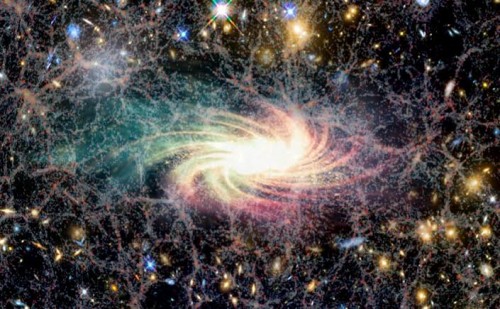The Milky Way, the galaxy we live in, is one of hundreds of billions of galaxies strewn across the universe. Their variety is stunning: spirals, ring galaxies shaped like star-studded loops, and ancient galaxies that outshine virtually everything else in the universe.
But despite their differences, and the mind-boggling distances between them, scientists have noticed that some galaxies move together in odd and often unexplained patterns, as if they are connected by a vast unseen force.
Galaxies within a few million light years of each other can gravitationally affect each other in predictable ways, but scientists have observed mysterious patterns between distant galaxies that transcend those local interactions.
These discoveries hint at the enigmatic influence of so-called “large-scale structures” which, as the name suggests, are the biggest known objects in the universe. These dim structures are made of hydrogen gas and dark matter and take the form of filaments, sheets, and knots that link galaxies in a vast network called the cosmic web. We know these structures have major implications for the evolution and movements of galaxies, but we’ve barely scratched the surface of the root dynamics driving them.
Scientists are eager to acquire these new details because some of these phenomena challenge the most fundamental ideas about the universe.
“That’s actually the reason why everybody is always studying these large-scale structures,” said Noam Libeskind, a cosmographer at the Leibniz-Institut for Astrophysics (AIP) in Germany, in a call. “It’s a way of probing and constraining the laws of gravity and the nature of matter, dark matter, dark energy, and the universe.”
Why are distant galaxies moving in unison?
Galaxies tend to form gravitationally bound clusters that belong to even larger superclusters. Earth’s long-form cosmic address, for instance, would have to note that the Milky Way is part of the Local Group, a gang of several dozen galaxies. The Local Group is inside the Virgo supercluster, containing more than 1,000 galaxies.
On these more “local” scales, galaxies frequently mess with each other’s spins, shapes, and angular velocities. Sometimes, one galaxy even eats another, an event known as galactic cannibalism. But some galaxies show dynamic links across distances too great to be explained by their individual gravitational fields.
For instance, a study published in The Astrophysical Journal in October found that hundreds of galaxies were rotating in sync with the motions of galaxies that were tens of millions of light years away.
“This discovery is quite new and unexpected,” said lead author Joon Hyeop Lee, an astronomer at the Korea Astronomy and Space Science Institute, in an email. “I have never seen any previous report of observations or any prediction from numerical simulations, exactly related to this phenomenon.”
Lee and his colleagues studied 445 galaxies within 400 million light years of Earth, and noticed that many of the ones rotating in a direction toward Earth had neighbors that were moving toward Earth, while those that were rotating in the opposite direction had neighbors moving away from Earth.
“The observed coherence must have some relationship with large-scale structures, because it is impossible that the galaxies separated by six megaparsecs [roughly 20 million light years] directly interact with each other,” Lee said.
Lee and his colleagues suggest that the synchronized galaxies may be embedded along the same large-scale structure, which is very slowly rotating in a counter-clockwise direction. That underlying dynamic could cause the kind of coherence between the rotation of the studied galaxies and the motions of their neighbors, though he cautioned that it will take a lot more research to corroborate his team’s findings and conclusions.
While this particular iteration of weirdly synced up galaxies is novel, scientists have observed odd coherences between galaxies at even more mind-boggling distances. In 2014, a team observed curious alignments of supermassive black holes at the cores of quasars, which are ancient ultra-luminous galaxies, that stretch across billions of light years.
Led by Damien Hutsemékers, an astronomer at the University of Liège in Belgium, the researchers were able to observe this eerie synchronicity by watching the universe when it was only a few billion years old, using the Very Large Telescope (VLT) in Chile. The observations recorded the polarization of light from nearly 100 quasars, which the team then used to reconstruct the geometry and alignment of the black holes at their cores. The results showed that the rotation axes of 19 quasars in this group were parallel, despite the fact that they were separated by several billion light years.
The discovery, which was published in the journal Astronomy

Scientists are finding that galaxies can move with each other across huge distances, and against the predictions of basic cosmological models. The reason why could change everything we think we know about the universe.




